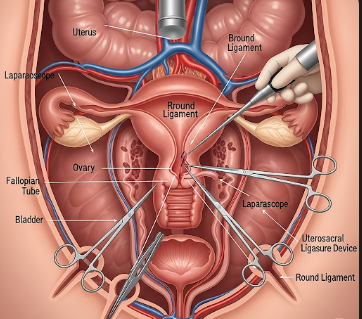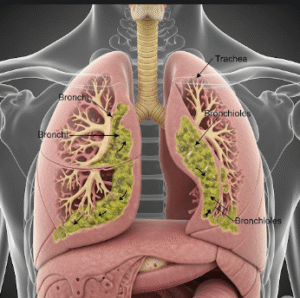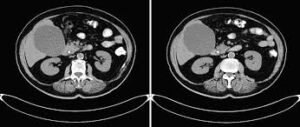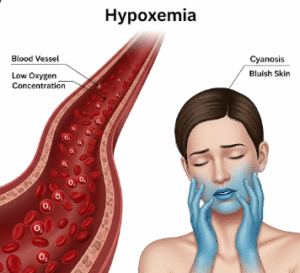Overview
Laparoscopic hysterectomy is a minimally invasive surgical procedure to remove the uterus using small abdominal incisions and specialized instruments. Compared to traditional abdominal hysterectomy, it offers smaller scars, less pain, faster recovery, and shorter hospital stays.
South Korea is recognized for advanced gynecological laparoscopic surgery, robotic-assisted techniques, and expert post-operative care, making it a top destination for women seeking safe and effective hysterectomy with minimal downtime.
What is Laparoscopic Hysterectomy?
Laparoscopic hysterectomy involves:
- Small incisions in the abdomen (usually 3–5 incisions, 0.5–1 cm each)
- Insertion of a laparoscope (camera) and surgical instruments to remove the uterus
- Minimally invasive removal of the uterus, sometimes including the cervix, ovaries, or fallopian tubes if indicated
Types of laparoscopic hysterectomy:
- Total Laparoscopic Hysterectomy (TLH) → Entire uterus including cervix removed
- Laparoscopic-Assisted Vaginal Hysterectomy (LAVH) → Laparoscope used to assist removal via vaginal route
- Robotic-Assisted Laparoscopic Hysterectomy → Surgeon uses robotic instruments for precision and dexterity
Indications include:
- Uterine fibroids
- Endometriosis
- Adenomyosis
- Abnormal uterine bleeding
- Early-stage uterine or cervical cancer
What are the Benefits?
- Minimally invasive approach → smaller scars and better cosmetic results
- Reduced post-operative pain and faster recovery
- Shorter hospital stay → usually 1–2 days
- Early return to normal activities → light activity within days, full recovery within 4–6 weeks
- Reduced risk of infection compared to open surgery
- High precision → allows removal of uterus while preserving surrounding organs
- Advanced robotic-assisted options for complex cases
Procedure Details
1) How should I prepare for Laparoscopic Hysterectomy?
- Preoperative evaluation → Blood tests, ultrasound, MRI, ECG, Pap smear, and sometimes endometrial biopsy
- Medication review → Stop blood thinners or specific medications as advised
- Fasting → Typically 6–8 hours before surgery
- Bowel preparation → May be recommended for better visualization during surgery
- Pre-operative consultation → Discuss type of hysterectomy, surgical approach, recovery plan, and potential complications
2) What happens during the procedure Laparoscopic Hysterectomy?
- Anesthesia → General anesthesia administered by an experienced anesthesiologist
- Surgical steps →
- Small abdominal incisions made for laparoscope and instruments
- Uterus carefully dissected and removed through incisions or vaginally
- Fallopian tubes or ovaries may be removed if indicated
- Hemostasis ensured and incisions closed with absorbable sutures
- Duration → Usually 1–2 hours depending on complexity
- Monitoring → Continuous heart rate, blood pressure, and oxygen saturation monitoring
3) What happens after a Laparoscopic Hysterectomy?
- Recovery room → Patient monitored until fully awake and stable
- Hospital stay → Typically 1–2 days
- Pain management → Oral or IV analgesics
- Activity restrictions → Avoid heavy lifting, sexual activity, and strenuous exercise for 4–6 weeks
- Wound care → Keep small incisions clean and dry
- Follow-up visits → Monitor healing, check for complications, and assess hormone levels if ovaries removed
Risks / Benefits
Risks
- ➤ Bleeding or hematoma formation
- ➤ Infection at incision sites or internally
- ➤ Injury to bladder, ureters, or bowel (rare)
- ➤ Blood clots in legs or lungs
- ➤ Early menopause if ovaries removed
- ➤ Rare complications related to anesthesia or robotic instruments
Benefits
- ➤ Minimally invasive with faster recovery
- ➤ Smaller scars and better cosmetic outcome
- ➤ Shorter hospital stay and less post-operative pain
- ➤ Effective treatment for various uterine conditions
- ➤ Comprehensive care in expert Korean hospitals
Recovery and Outlook
- Immediate recovery → Mild abdominal discomfort, bloating, or shoulder pain from gas used in surgery
- Hospital stay → Usually 1–2 days
- Return to light activities → Within 1 week; full recovery in 4–6 weeks
- Long-term outlook → Excellent; symptoms like heavy bleeding, pelvic pain, or fibroid-related issues resolved
- Hormonal considerations → Hormone replacement may be advised if ovaries are removed
- Follow-up care → Regular gynecological evaluations, monitoring for complications, and counseling for hormonal adjustments
South Korea offers advanced post-operative care, including pain management, physiotherapy, counseling, and robotic surgery follow-up, ensuring optimal recovery.
When To Call the Doctor
Contact your surgeon immediately if you notice:
- ⚠️ Heavy bleeding or persistent vaginal discharge
- ⚠️ Fever, chills, or signs of infection
- ⚠️ Severe abdominal pain not relieved by medications
- ⚠️ Swelling, redness, or opening of incision
- ⚠️ Shortness of breath, leg swelling, or chest pain (possible blood clot)
- ⚠️ Urinary problems or bowel difficulties
Best Korea Option / Process
South Korea is a leading destination for laparoscopic hysterectomy due to:
- Highly skilled gynecologists with expertise in minimally invasive and robotic surgery
- Advanced surgical and robotic equipment
- Comprehensive pre- and post-operative care
- Short hospital stays and faster recovery
- International patient support, including language assistance, coordination, and follow-up
Top Hospitals for Laparoscopic Hysterectomy in Korea:
- Asan Medical Center, Seoul – Expert minimally invasive gynecologic surgery
- Samsung Medical Center – Robotic-assisted laparoscopic hysterectomy for complex cases
- Seoul National University Hospital (SNUH) – Comprehensive care and follow-up
- Yonsei Severance Hospital – High success rates with advanced surgical technology
👉 For women with uterine conditions requiring minimally invasive surgery, Laparoscopic Hysterectomy in Korea offers safe, effective, and advanced treatment with rapid recovery and minimal scarring.













